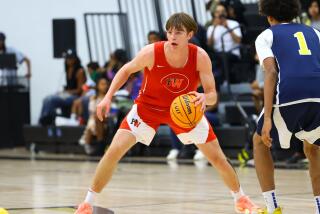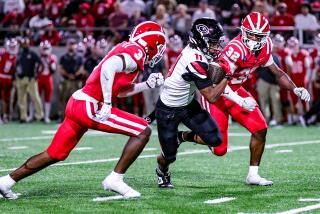Courting of Marco Baldi: Strange Recruiting Battle on 2 Continents
When Marco Baldi announced recently that he would play basketball at St. John’s next year, one of the most bizarre recruiting wars in recent memory ended. The pursuit of this 6-foot-11 Italian schoolboy with a nice outside shot sounded like a who’s-got-the-microfilm mystery.
If you don’t believe that, ask St. John’s Coach Lou Carnesecca, whose tongue is still tied from speaking Italian with Baldi’s “people” in Milan. Chat with USC Coach Stan Morrison, who saw Baldi land on his front doorstep two years ago only to watch him defect to New York. Converse with Maryland Coach Lefty Driesell, who also came up empty but returned from Europe with an armload of Gucci bags and a 7-2 German player, instead.
The courting of Baldi, an Italian exchange student at Long Island Lutheran High School in Brookville, N.Y., spanned two continents. It included secretive overseas phone calls, plane trips to Milan, meetings in airports. Baldi was far from the best high school player available this year, but he fit everyone’s need for a big man--and that meant a free-for-all.
“It’s been unusual,” Carnesecca said. “But he’s 6-11, and everybody chases big guys.”
Baldi is an intelligent, well-built 18-year-old who averaged 18 points and 12 rebounds. A banker’s son, he has a 4.0 grade-point average and is fluent in French and English, with a smattering of German.
He also was utterly bewildered by American recruiting.
“I never saw anything like it,” he said. “It was crazy.”
He is the first Italian player allowed out of the strict Italian club system to play for an American college. That may have made him more of a catch than his physical credentials and accounted for some of the craziness. Lutheran Coach Bob McKillop, who also coached Maryland’s Steve Rivers, North Carolina’s Matt Doherty and St. John’s Bill Wennington, never figured Baldi would be his most recruited player.
“The thing is, I’ve coached a lot of players who were more talented,” McKillop said. “Marco is a good player, but he’s no great talent. He’s not a franchise. I’ve had a number of Division I players, but none with this kind of fanfare. It’s the Italian thing.”
Baldi narrowed his choices to St. John’s, Maryland and USC several weeks ago, then decided against Maryland on the advice of his club, Simac, one of the best in Italy. Simac advised him to choose USC, but he finally chose St. John’s because he can play as a freshman.
“It’s the best situation for me,” said Baldi, who lives a half hour from campus with his host family. “I feel comfortable with the coach, and it’s a chance to play right away.”
“We didn’t bring him here to sit on the bench,” Carnesecca said.
The pursuit of Baldi came to a hilarious head recently at JFK Airport in New York. During spring vacation, he returned to Milan to play for his club in a tournament. Just before leaving, he ran into Carnesecca, who just happened to be strolling around the airport. When he got on the plane, he saw Maryland assistant Ron Bradley. When he arrived for the tournament, Carnesecca and a USC assistant coach, David Spencer, were sitting together in the stands. Spencer had played for Dan Peterson, general manager of Simac.
“It was intrigue, cloak-and-dagger stuff,” said McKillop. “To see all the leg work was remarkable. One coach started going to Italy, and then they all did. School A would do something, and then School B would follow.”
There were daily phone calls, letters and countless visits to Italy by coaches and assistants. Carnesecca exercised his fluent Italian, the USC coach tried to remember the language from an old college course. Driesell made no attempt to speak Italian, relying on Baldi’s excellent English.
When Baldi became somewhat upset by all the attention, McKillop all but sequestered him with his host family, cutting off contact with the press and asking the competing schools to restrict their efforts to letters.
The pursuit may have taught the American coaches a thing or two about recruiting. Baldi postponed his decision until long after most American prospects had made their choices in the spring. He spent long hours consulting his parents and general manager during his trip to Milan.
“Those European kids do it different,” Carnesecca said. “They talk to their mom and dad.”
If Baldi was naive about the recruiting process, it is because there is nothing like recruiting in Italy. The Italian club system is completely separate from the school system; a player signs with a club at an early age and is bound to it the rest of his career.
“It’s a funny thing about that,” McKillop said. “They think schools are for learning.”
Jet-setting was not the adventure it sounds like for the coaches. Morrison, who visited Milan twice, did as much sightseeing as anybody. His sole act of tourism consisted of jumping out of a cab in the rain, racing inside a museum for a five-minute look at a painting, and returning to the cab.
“It wasn’t as glamorous as it sounds,” said USC’s Morrison, who first saw Baldi when he played his sophomore year in nearby Irvine, before transferring to Lutheran. “When you go on Tuesday and come back Thursday, it’s not much fun. Gyms smell the same all over the world.”
Driesell spent most of his three-day visit meeting with Baldi’s parents or shopping. “It was no big deal,” he said. “I just watched him practice. I went around Milan a little, bought some Italian shoes, some china, some Gucci purses for my wife.”
Although he lost Baldi, he did sign Christoph Weisheit, a 7-2 exchange student from Cologne. Weisheit plays at Effingham High School in Illinois, the school that polished Indiana’s Uwe Blab of West Germany. Weisheit is the tallest player ever to sign a letter of intent to Maryland and averaged 20.1 points and 6.5 rebounds at Effingham.
“I don’t think there are that many good players over there,” Driesell said. “Marco is not a Patrick Ewing. He’s just a big kid who needs to play. If he was that good, he’d be playing for his club already.”
Another twist to the story is that Baldi’s club could call him back to Milan any time. He will probably play at least two seasons at St. John’s and could stay for the full four, but that depends on how quickly he develops.
“It’s better to have loved and lost, than never to have loved,” Carnesecca said. “We’ll prepare him, and then he’ll go back. That’s where his future is.”
More to Read
Go beyond the scoreboard
Get the latest on L.A.'s teams in the daily Sports Report newsletter.
You may occasionally receive promotional content from the Los Angeles Times.






